Cities are facing growing risks as a result of climate change. Many are in high-risk locations such as coastlines, floodplains or islands, and most face a threat from climate hazards beyond the scope of past experience.
Cities’ built environment can also exacerbate impacts. Some increase in climate risk is already locked-in due to existing emissions, and risks will be significantly worse if action to mitigate climate change falls short of the goal to limit warming to 1.5°C.
To protect the lives and livelihoods of urban residents, cities must adapt and improve their resilience to current and future climate impacts.
To help cities to navigate the many adaptation options and strategies available, this report identifies and explains 15 high-potential actions across five climate hazards – extreme heat, drought, wildfire, inland flooding and coastal flooding – and those that can help cities build systemic resilience.
A new report from C40 Cities and McKinsey Sustainability hopes to help cities deal with the “dizzying array of options” for climate adaptation, so they can set priorities and take action.
The report details 15 high-potential actions, which include investment in infrastructure like coastal barriers as well as behavioral actions such as water conservation behavior programs.
The report also identifies three key messages:
- Nature-based solutions are critical to adaptation and comprise some of the most attractive actions both in terms of their impact on reducing risks and their feasibility. Nature-based solutions include the planting of street trees, river catchment management, blue and green urban drainage solutions and coastal nature-based barriers. Crucially, nature-based solutions often have benefits beyond adaptation, including for carbon sequestration, health and wellbeing, and economic prosperity.
- Cities should invest in actions that increase resilience systemically, as a foundation to adapting to specific and immediate hazards. Systemic resilience includes increasing awareness of physical climate risks, incorporating risk into city processes, optimizing emergency response, and enhancing financial and insurance programs.
- Finally, this report is a call to targeted action. In a resource-constrained world, by prioritising the most effective and feasible actions in adaptation strategies cities can focus on executing them well and build momentum to do more.
Photo of waterfront infrastructure reconstruction in Dinant, Belgium by David Mark from Pixabay.

